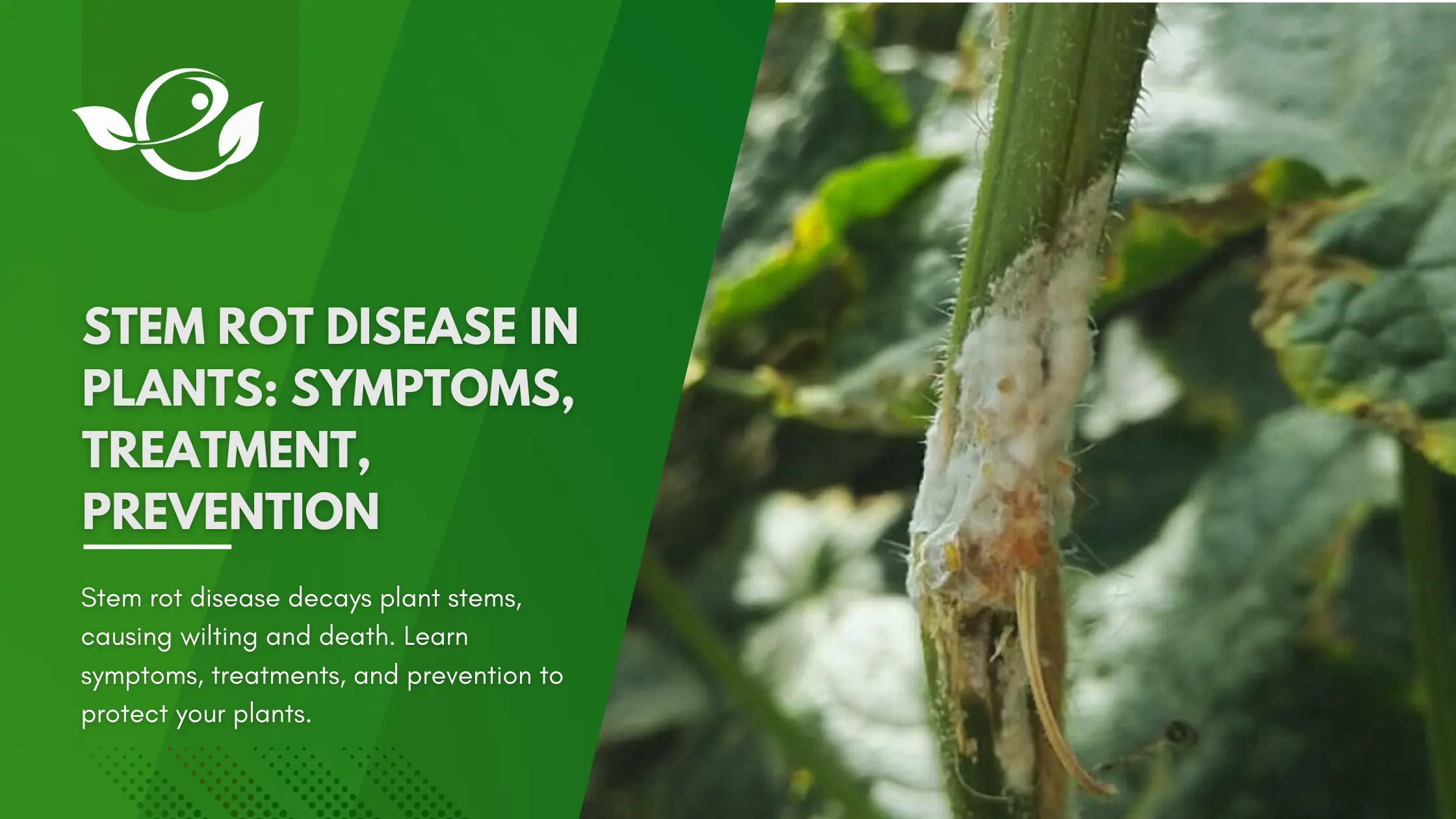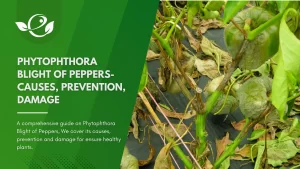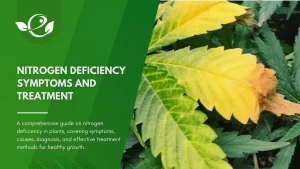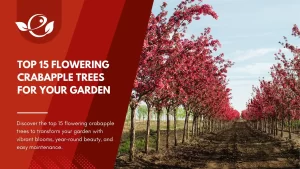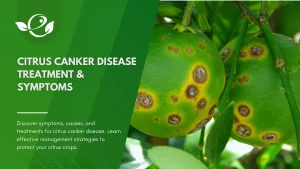Table of Contents
In the vast, intricate world of gardening and agriculture, where each plant represents a tiny ecosystem, diseases lurk in every corner. Among these diseases, stem rot stands as a silent assassin, slowly creeping up the stems of plants, often unnoticed until it’s too late. This disease can be devastating, turning vibrant, healthy plants into decaying remnants of their former selves. The sight of a withering plant, its stem turning mushy and lifeless, is a heart-wrenching experience for gardeners and farmers alike. Yet, this common affliction remains an enigma to many, its symptoms are often mistaken for other ailments, and its true nature is misunderstood.
Stem rot is not just another disease; it is a pervasive threat that can strike a wide range of plants, from delicate flowers in a home garden to essential crops in vast agricultural fields. Its impact goes beyond the physical damage to plants; it can lead to significant economic losses and emotional distress for those who tend to their plants with care and dedication. Understanding stem rot is crucial for anyone involved in plant cultivation, whether on a small scale or large.
In this comprehensive guide, we will delve deep into the world of stem rot, unravelling its mysteries and providing you with the knowledge needed to combat it effectively. We will explore its symptoms, so you can catch it early, and discuss the various treatments available to save affected plants. Most importantly, we will arm you with the preventive measures necessary to keep this disease at bay, ensuring that your plants remain healthy and thriving. Let us embark on this journey of discovery and empowerment, turning the threat of stem rot into an opportunity to become more vigilant and knowledgeable gardeners and farmers.
What is Stem Rot Disease?
Stem rot is a plant disease characterized by the decay of a plant’s stem, often at or near the soil line. It can be caused by a variety of pathogens, including fungi, bacteria, and sometimes even certain pests. The disease typically manifests in conditions where moisture levels are high, and air circulation is poor, creating an ideal environment for these pathogens to thrive.
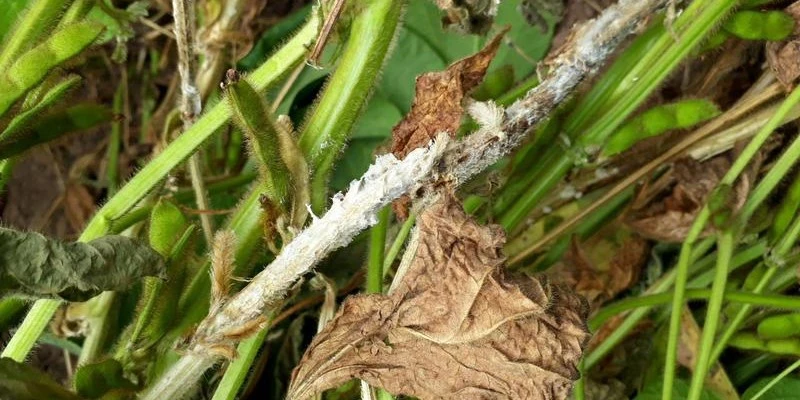
Causative Agents
Stem rot is caused primarily by fungi, but bacteria and oomycetes (fungus-like organisms) can also be responsible. Some of the most common pathogens include:
- Sclerotinia spp.: This fungus causes white mold or cottony rot, leading to soft, mushy stems and a white, cotton-like growth on the affected areas.
- Rhizoctonia solani: Known for causing damping-off in seedlings, this fungus also affects mature plants, leading to brown, dry rot at the stem base.
- Phytophthora spp.: A notorious pathogen responsible for root and stem rot, particularly in wet conditions. It causes dark, water-soaked lesions that eventually turn necrotic.
Susceptible Plants
Stem rot does not discriminate; it affects a wide variety of plants. Vegetables such as tomatoes, peppers, and beans are particularly susceptible, as are ornamental flowers like roses and daisies. Even large trees and shrubs can fall victim to stem rot if conditions are favourable for the pathogens.
Plants growing in poorly drained soils, or those that are watered excessively, are at a higher risk. Additionally, plants that are overcrowded or have poor air circulation are more likely to develop stem rot, as these conditions create a humid environment where pathogens can thrive.
Symptoms of Stem Rot Disease
Recognizing stem rot early is crucial for effective management. The symptoms can vary depending on the pathogen involved and the stage of the disease, but there are some common signs to look out for.
Early Signs
In the initial stages, stem rot can be difficult to detect. However, keen observation can reveal subtle signs that something is amiss. One of the first indicators is often the yellowing or wilting of leaves, particularly those closest to the base of the plant. This is a result of the plant’s vascular system being compromised, preventing water and nutrients from reaching the leaves.
Another early sign is discolouration at the base of the stem. This discolouration may appear as a slight browning or darkening of the stem tissue, often accompanied by a softening of the affected area. In some cases, you might notice a slight constriction at the base of the stem, as if the stem is being “choked.”
Progressive Symptoms
As the disease progresses, the symptoms become more pronounced. The affected stem will typically turn brown or black and become soft and mushy to the touch. This is due to the breakdown of plant tissues caused by the pathogens. In some cases, the stem may emit a foul odor, particularly if bacterial rot is involved.
Symptoms vary among host species, but there are a number of similarities.
- Initially, water-soaked spots with an irregular shape appear on fruits, leaves, or petioles. As they enlarge, the affected areas become covered by a white, profuse cottony mold, at later stages scattered with visible grayish or black wart-like reproductive structures called sclerotia.
- “Dry” lesions may develop on at the base of stems and branches, clearly delimited from the healthy tissues.
- During later stages, the fungus encircles the stem and the upper parts of the plant tend to wilt, turn brown and die.
- Hardened fungal growth form inside the stem and replace the plant tissues. This may result in death and consequent lodging of plants.
- Infected pods and seeds may shrivel or may be replaced by black fungal growth.
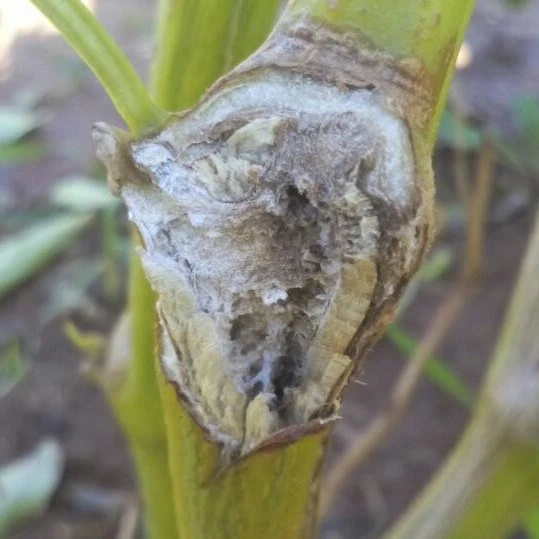

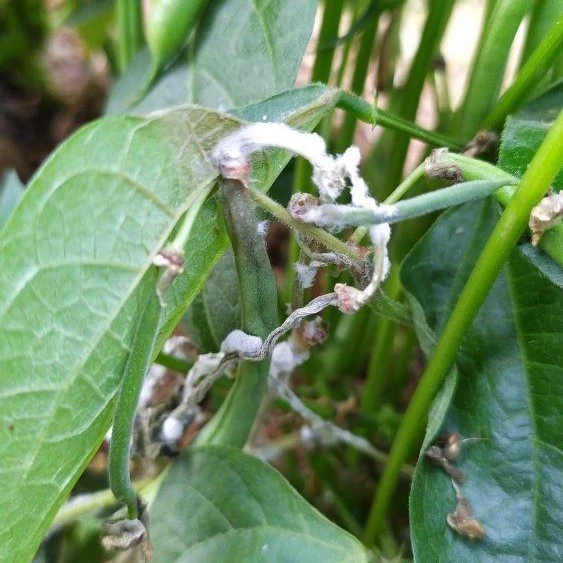
Identifying Stem Rot
Identifying stem rot involves closely examining the base of the stem and the surrounding soil. If you notice any soft, discoloured, or rotting areas on the stem, particularly near the soil line, it is likely that stem rot is present. Gently pulling back the soil around the base of the plant can reveal more extensive rot below the surface.
It is important to distinguish stem rot from other plant diseases that may cause similar symptoms. For example, root rot also leads to wilting and yellowing of leaves, but the primary damage occurs in the roots rather than the stem. In contrast, stem rot specifically affects the stem and often progresses upward from the soil line.
Causes and Risk Factors of Stem Rot Disease
Understanding the causes and risk factors of stem rot is essential for effective prevention and management. Several environmental and cultural factors can contribute to the development of this disease.
Environmental Conditions
Moisture is a critical factor in the development of stem rot. Excessive moisture around the base of the plant, whether due to overwatering, poor soil drainage, or prolonged periods of wet weather, creates an ideal environment for the pathogens that cause stem rot to thrive. High humidity and warm temperatures further exacerbate the problem, as they promote the growth and spread of fungi and bacteria.
Poorly drained soils, such as clay soils, are particularly problematic, as they tend to retain water, creating persistently wet conditions. In contrast, sandy soils, which drain quickly, are less likely to harbor the pathogens responsible for stem rot.
Cultural Practices
Certain gardening practices can inadvertently increase the risk of stem rot. Overwatering is one of the most common mistakes, particularly in container gardens where drainage may be inadequate. Similarly, watering plants from overhead, rather than at the base, can cause water to collect around the stem, creating a breeding ground for pathogens.
Overcrowding plants is another common issue, as it reduces air circulation around the base of the plants, leading to increased humidity and moisture retention. Using contaminated tools, pots, or soil can also introduce pathogens to healthy plants, spreading stem rot throughout the garden.
Biological Factors
Stem rot pathogens can be transmitted through various means. Contaminated soil, water, or plant debris can harbor the spores or bacteria responsible for the disease. Insects and other pests can also play a role in spreading stem rot, particularly if they feed on infected plants and then move to healthy ones. Some pathogens, such as Sclerotinia, produce long-lasting spores called sclerotia that can survive in the soil for years, making it difficult to eradicate the disease once it has taken hold.
Treatment of Stem Rot Disease
Once stem rot is detected, prompt action is necessary to save the affected plants and prevent the disease from spreading. Treatment options vary depending on the severity of the infection and the specific pathogen involved.
Cultural Control
- The first step in treating stem rot is to improve cultural practices that may have contributed to the disease. Adjusting watering techniques is crucial; plants should be watered at the base rather than overhead, and the soil should be allowed to dry out slightly between waterings to prevent excess moisture buildup.
- Improving soil drainage is another important cultural control measure. In garden beds, this may involve amending the soil with organic matter to improve its structure and drainage.
- In container gardens, ensuring that pots have adequate drainage holes and using a well-draining potting mix can help prevent water from accumulating around the plant’s base.
- Crop rotation is also beneficial, particularly in vegetable gardens. Rotating crops can help break the life cycle of soil-borne pathogens, reducing the risk of reinfection in subsequent growing seasons.
Chemical Control
In cases where stem rot is caused by fungal pathogens, the use of fungicides may be necessary to halt the disease’s progression. Fungicides should be applied according to the manufacturer’s instructions, with particular attention to the timing and frequency of applications. It is important to use fungicides that are labelled for the specific pathogen causing the stem rot and to follow all safety precautions when handling and applying these chemicals.
Always consider an integrated approach with preventive measures together with biological treatment if available. Foliar fungicide applications are only recommended in fields with severe disease development. Treatments will vary depending on the crop in question and the developmental stage. Control of Sclerotinia diseases of cabbage, tomato and beans is difficult. However, fungicides based on iprodione or copper oxychloride (3 g/l of water) provide effective control on lettuce and peanuts. The development of resistance has been described for some of these compounds.
For bacterial stem rot, bactericides may be used, although they are generally less effective than fungicides. Copper-based bactericides are commonly recommended, but their use should be limited, as overuse can lead to copper buildup in the soil, which can be toxic to plants.
Biological Control
Biological control involves using natural predators or beneficial microorganisms to combat stem rot pathogens. For example, certain beneficial fungi and bacteria can outcompete or inhibit the growth of harmful pathogens in the soil, reducing the incidence of stem rot.
Granular formulations of spores of the fungal parasite Coniothyrium minitans or species of Trichoderma have been applied to soils to reduce the fungal load of Sclerotinia and hinder the development of the disease. Products containing Trichoderma are available for use in both commercial agriculture and home gardening.
Another biological control option is the use of mycorrhizal fungi, which form symbiotic relationships with plant roots and enhance the plant’s ability to absorb water and nutrients. By promoting healthy root growth, mycorrhizal fungi can help plants resist stem rot and other soil-borne diseases.
Physical Removal
In severe cases of stem rot, where the plant is too far gone to be saved, physical removal may be the only option. This involves carefully digging up and disposing of the affected plant to prevent the disease from spreading to nearby healthy plants.
When removing a diseased plant, it is important to remove as much of the root system as possible, as the pathogens may be present in the soil around the roots. Infected plant material should be disposed of in a manner that prevents the spread of the disease, such as by burning or sealing it in plastic bags before discarding it.
All gardening tools used in the removal process should be thoroughly cleaned and disinfected to prevent the spread of pathogens to other plants.
Prevention of Stem Rot Disease
Preventing stem rot is the most effective way to protect your plants from this devastating disease. By implementing a combination of good cultural practices, environmental management, and regular monitoring, you can significantly reduce the risk of stem rot in your garden or farm.
- One of the most important preventive measures is selecting plant varieties that are resistant to stem rot. Many modern cultivars have been bred for increased resistance to common diseases, including stem rot, making them a better choice for areas where the disease is known to be a problem.
- Maintaining overall plant health is also key to preventing stem rot. Healthy plants are better able to resist infection and recover from minor damage that might otherwise lead to disease. Proper fertilization, watering, and pruning practices all contribute to maintaining plant vigor and reducing the likelihood of stem rot.
- Managing the environment around your plants is crucial for preventing stem rot. Improving soil drainage is one of the most effective ways to reduce the risk of the disease. In garden beds, this can be achieved by amending the soil with organic matter, such as compost or well-rotted manure, to improve its structure and drainage capabilities.
- In areas with heavy clay soils, consider creating raised beds to elevate the root zone and improve drainage. In container gardens, ensure that pots have adequate drainage holes and use a well-draining potting mix.
- Mulching is another useful practice for preventing stem rot, as it helps regulate soil moisture levels and prevents soil from splashing onto the stems of plants during watering or rain. However, it is important to avoid piling mulch directly against the stems, as this can create a moist environment conducive to stem rot.
- Regular monitoring of your plants is essential for catching stem rot in its early stages when it is easier to treat. Inspect plants regularly, paying close attention to the base of the stems and the surrounding soil. Look for any signs of discolouration, softening, or wilting, and take immediate action if any symptoms are detected.
- Implementing a proactive disease prevention plan is also beneficial. This might include rotating crops, using disease-resistant varieties, and maintaining good garden hygiene by removing plant debris and controlling weeds that can harbour pathogens.
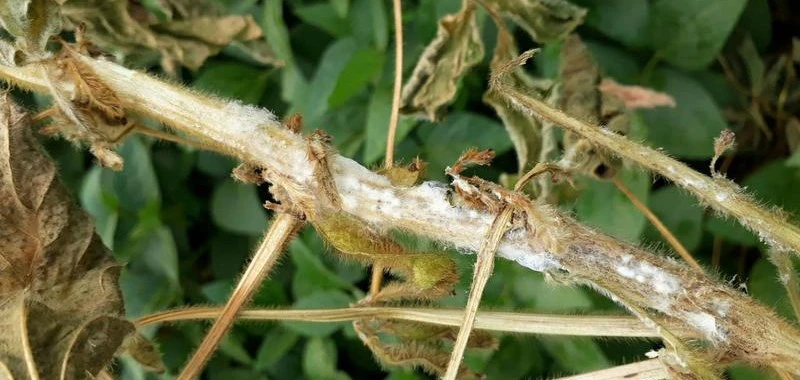
- Use healthy seeds from a certified source.
- Choose resistant or more tolerant varieties, if available for the crop in question.
- Do not plant on previously infested land.
- Use a wider row distance allowing good ventilation of the crops.
- Use wires or stakes to support the plants.
- Monitor the field for signs of the disease.
- Control weeds in and around the field.
- Prune infected branches or crop parts.
- Do not over-fertilize during late stage of growth.
- Avoid excessive irrigation during later stages of plant growth.
- Do not till the land as no-till systems have a lower risk of disease development.
- Rotate crops with non-host plants such as cereals.
By staying vigilant and taking preventive measures, you can significantly reduce the risk of stem rot and keep your plants healthy and thriving.
Conclusion
Stem rot is a formidable opponent in the garden, capable of causing significant damage if left unchecked. However, with the right knowledge and tools, it is possible to manage and prevent this disease effectively. By understanding the symptoms and causes of stem rot, you can take early action to treat affected plants and prevent the disease from spreading. Implementing good cultural practices, improving soil drainage, and regularly monitoring your plants are all key strategies for keeping stem rot at bay.
Remember, the health of your plants is in your hands. By staying informed and proactive, you can protect your garden from stem rot and enjoy the beauty and bounty of healthy, thriving plants.
